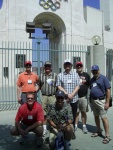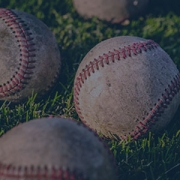SABR 41: L.A. Ballparks Saw Much Success in Coast League Days
LONG BEACH — On Saturday, July 9, more than 100 SABR members and guests boarded two deluxe Gold Coast Tour buses to see and to hear about five historical ballpark sites where baseball used to be played in Los Angeles.
Photos: A slideshow of the SABR 41 Historical Ballparks Tour can be viewed at ACAphotos.com
 We first visited the city of Vernon, where the Vernon Tigers played from 1909 through 1920, with a change of venue from 1913 through mid-1915, when they constructed a ballpark in Venice, California. Two parks existed in Vernon: an expansion of Southside Park, called Vernon Park I. It seated about 4,000 people and was a relatively small park. For the 1913 season a park was built by owner Ed Maier and the city of Venice, and the team became known as the Venice Tigers. For the 1916 season, the team moved back to Vernon, taking their park with them, board by numbered board. The park was expanded when more land was purchased, now seating about 10,000 people. The bigger park cut down tremendously on home runs. (Only Sunday morning games, with an occasional weekday game, were played in Vernon by the Los Angeles team or the Vernon team, whomever was in town. This arrangement lasted until 1920, when the Vernon Tigers moved to Los Angeles’ Washington Park for all their games.) In 1925, the Vernon club was sold to San Francisco interests and became the San Francisco Missions. The site of the Vernon ballpark is now occupied by Hannibal Industries, which produces industrial shelving, as well as 16.5 additional acres. Al Parnis, Vice President of SABR’s Allan Roth Chapter conducted this segment of the tour.
We first visited the city of Vernon, where the Vernon Tigers played from 1909 through 1920, with a change of venue from 1913 through mid-1915, when they constructed a ballpark in Venice, California. Two parks existed in Vernon: an expansion of Southside Park, called Vernon Park I. It seated about 4,000 people and was a relatively small park. For the 1913 season a park was built by owner Ed Maier and the city of Venice, and the team became known as the Venice Tigers. For the 1916 season, the team moved back to Vernon, taking their park with them, board by numbered board. The park was expanded when more land was purchased, now seating about 10,000 people. The bigger park cut down tremendously on home runs. (Only Sunday morning games, with an occasional weekday game, were played in Vernon by the Los Angeles team or the Vernon team, whomever was in town. This arrangement lasted until 1920, when the Vernon Tigers moved to Los Angeles’ Washington Park for all their games.) In 1925, the Vernon club was sold to San Francisco interests and became the San Francisco Missions. The site of the Vernon ballpark is now occupied by Hannibal Industries, which produces industrial shelving, as well as 16.5 additional acres. Al Parnis, Vice President of SABR’s Allan Roth Chapter conducted this segment of the tour.
The next stop was L.A.’s Wrigley Field. The Los Angeles Angels played there from September 29, 1925, through the end of the 1957 season. Lights were installed in 1931. The park has the distinction of being known as the best minor league park in the country in its day. It was double-decked and seated approximately 20,500 people. Its best team was most likely the 1934 Los Angeles Angels, who won 137 games while losing only 50. Many say the most exciting game ever played there was a 1947 playoff game between the Angels and the San Francisco Seals. A pitiching duel for seven and a half innings, the game was won by an Angels grand slam followed by a solo homer in the bottom of the eighth inning to make Los Angeles the 1947 Pacific Coast League champions. The park was demolished in the late 1960s to make way for the King-Drew Medical Facility, as well as recreation areas where soccer and baseball are now played. Chuck Carey, past president of the Allan Roth Chapter, conducted this segment of the tour.
The third stop on our tour was the Los Angeles Memorial Coliseum, home to the Los Angeles Dodgers from 1958 through 1961. Fitting a diamond-shaped ballpark into an oval-shaped stadium was no easy task. But the Dodgers won the 1959 World Series and thousands came out to watch their games on a regular basis. Los Angeles had never before seen regular-season major league baseball, and World Series attendance records were set that will probably never be broken. Players were not happy with the stadium, but team management enjoyed the extra revenue that came from their visits to Los Angeles. The stadium, which opened in 1923, is still in use with large crowds for University of Southern California football games and concerts. Bob Timmerman, Vice President of the Allan Roth Chapter, conducted this segment of the tour.
The fourth stop was Washington Park, right in the heart of Los Angeles, not far from downtown. The Los Angeles Angels and Vernon Tigers jointly owned the park and played the majority of their games there. It seated between 10,000 to 12,000 people. The L.A. team was more sucessful than the Vernon team, although Vernon won pennants i n1918,1919, and 1920, when Hollywood actor Roscoe “Fatty” Arbuckle was a stockholder and had a good bit to do wiith obtaining quality players. The park was in use from 1911 through 1925, when the Angels moved to Wrigley Field and the Tigers moved to San Francisco to become the San Francisco Missions. The site is currently home to the Los Angeles Furniture Mart. Rick Smith, longtime SABR member and former general manager of the California League’s Bakersfield Blaze, conducted this segment of the tour.
The fifth and final stop on our tour was to the site of Gilmore Field, home to the Hollywood Stars from 1939 through 1957. The park held about 15,000 people and was very fan-friendly. Any seat in Gilmore Field was a good seat, as the stands were very close to the field. The Stars struggled in the early Gilmore years, but hit their stride in 1949 with their first pennant at Gilmore Field. This was followed by pennants in 1952 and 1953, with first-division finishes the other six seasons before the park closed. Many Hollywood celebrities and movie stars were stockholders in the ballclub. Bob Cobb, who owned the Brown Derby restaurants, was the force behind the club, with movie stars such as Gary Cooper, George Raft, Robert Taylor, Cecil B. DeMille, Barbara Stanwyck and Bing Crosby holding significant shares of stock. The first thing many fans would do when they came into the park was look to see which movie stars were there that night, as their names were written on back of their box-seat locations. The site is the current home of CBS Television City, which occupies the park site plus additional acreage. Jerry Mezetow, longtime Allan Roth Chapter member and SABR researcher, conducted this segment of the tour.
— Al Parnis
View more photos from the SABR 41 Historical Ballparks Tour below (courtesy of Maxwell Kates):
Originally published: July 14, 2011. Last Updated: July 27, 2020.



